Opium is the dried latex obtained from the opium poppy. Opium addiction is the most prevalent addiction in Iranian society. During the last two decades "congress 60" a nongovernmental organization, has been performed a taper off treatment of opium associated with a package of psychological treatment group classes. While the effectiveness of taper off method in opium addiction has been confirmed, molecular mechanisms of this treatment in addicts are not clarified. BDNF gene is a brain-derived neurotrophic factor which is related to several molecular mechanisms of the brain including memory. 5-HTTPLR is a transporter of serotonin that is related to the decision-making process.
In present study mRNA level of BDNF and 5-HTTPLR genes in peripheral blood of 20 non-psychiatric persons and 79 opium addicted individuals before and after six months period of taper off treatment was examined by using Real-Time PCR and confirmed by protein level analysis using Western blotting. In addition, executive functions including memory and decision making were analyzed in all participants.
Results showed significant down expression of BDNF and 5-HTTPLR in addict persons vs. non psychiatric persons. Also significantly increase detected in BDNF (p<0.01) and5-HTTPLR (p<0.01) expression level in addicts after six months of therapy period. Similar results with gene expression results revealed in protein level analysis. Also, significant improvements in memory and decision making were revealed in addicts after therapy and these improvements were correlated with the expression level of BDNF and 5-HTTPLR.
Findings revealed the effect of opium abuse and taper off treatment on the expression of BDNF and 5-HTTPLR. In addition, the association of BDNF mRNA level with psychological states of addict's individuals detected. Results of the present study may help to a better understanding of molecular and neuropsychological mechanisms of opium addiction and taper off treatment. Also, present BDNF and 5-HTTPLR as potential markers for screening the effectiveness of different kinds of addiction treatment.
Keywords: Taper off treatment, Opium, Congress 60, BDNF, 5HTTPLR
Addiction is a chronic and severe psychiatric disease that may cause major health, social and economic problems and causing 12.4% of deaths worldwide. Opioids are a class of addictive drugs that affect the nervous system and use to produce euphoric feelings as well as pain relief.1
Opioid addiction is characterized by a powerful, compulsive urge to use opioid drugs. Individuals who become addicted may prioritize drug abuse over all other activities in their lives that in turn may impact badly to their professional and personal life.2 Methadone maintenance treatment (MMT) is the most widely used treatment for opiate addiction that is designed to normalization of many physiological abnormalities caused by chronic use of short-acting opiates.3 MMT have potential side effects such as methadone dependence, low bone density, and even hepatotoxicity.4
Addictions heritability in different drugs and behaviors are different but ranged from 39 to 72 percent; which means that addiction could consider as a multifactorial genetic disease.5 Animal studies helped better understanding addiction neurobiology and the identification of several genes that mediate variation in drug preference and response. Several physiological and psychological pathways were found to euphoric and addictiveness of opioids. Most of these pathways are related to dopamine signaling. By the way, it is not completely clear that why the tendency to a drug, severity of addictive behavior, and abstaining traits are different between people.6 The neurobiological pathways that modulate reward, stress resiliency and behavior inhibition are among those that also underlie general addiction liability.7
Studies of polymorphisms in the endogenous genes of opioid and monoaminergic systems, which encode the receptor target of some endogenous opioids, heroin, or morphine such as μ opioid receptor, have contributed substantially to knowledge of genetic influences on opiate addiction.8 Variants of dopamine β-hydroxylase and dopamine, serotonin, and norepinephrine transporters have also been reported related to the neurobiology of addiction as well as anxiety and stress.9,10
Brain-derived neurotrophic factor (BDNF) regulates the survival and growth of neurons and influences synaptic efficiency and plasticity. The human BDNF genes located in 11p14.1consists of 11 exons, and alternative promoters and splicing produces distinct BDNF transcripts.11 Most of the BDNF transcripts can be detected not only in the brain but also in the blood cells, and make BDNF a potential good peripheral biomarker for several psychiatric diseases, behavioral abnormalities, and neuronal activities.12,13
5-HTTLPR (serotonin transporter linked polymorphic region) is a degenerate repeat polymorphic region in the SLC6A4 gene located in the 17q11.1-q12 human chromosome and encodes the serotonin transporter.14 5-HTT variants are associated with depressive responses to life stress and several other psychological situations and traits.15 Independent lines of evidence were showed SLC6A4 is significantly involved with decision-making processes the function that is strongly affected in addiction.16,17
Several treatment methods for opium addictions were not completely successful because these methods just focusing on the acute phase of illness and are not personalized. The personalized and targeted treatments based on genetic and neurobiological predictor biomarkers are highly needed to follow up the treatment methods during weeks and months.18 Molecular biology may help to reduce the side effects of treatments as well as choosing the personalized treatment methods for each subject by analysis of gene expression and protein level changes.19,20
During the last two decades "congress 60" a nongovernmental organization in the Islamic Republic of Iran, has been performed a taper off treatment of opium associated with a package of comprehensive psychological treatments, group classes, social caring, and harm reduction methods for patients and their family members. Opium addicts who became members of "congress 60" called passengers do not take any medication besides opium tincture (OT). During the 12 months, passengers will reduce the dosage of OT use while they are participating in the classes and group training of congress 60 which is including sports training, passing the courses about the reason of human tendency to addiction, and some cognitive-behavioral therapies. It is supposed that passengers finish the process and leave opium abuse completely after twelve months. More than 5000 Iranians were successfully finished the 12 months of treatments of congress 60 (called DST method) and cut the opium abuse until now. Five years follow-up in the DST method was shown one of the lowest rates of relapse in this method compared with other opioid addiction treatment methods. The present study aimed to examine the effectiveness of the DST method by using molecular biology and neuropsychological testing.
Subjects recruitments and Samplings periods
The present study is six months follow-up of addicts who registered for taper treatments in congress 60. In the beginning, 200 male subjects with opium addiction that were registered in congress 60, have been recruited. At the end of the study, 79 opium-addicted individuals who completed all the examinations before and after six months period of taper off-treatment were included in the data analysis. Twenty non-psychiatric male subjects from family members of addicts were recruited for the control group. The Control group completed only the first time examinations. Subjects with IQ total score (Wechsler Abbreviated Intelligence Scale, 1999) lower than < 80 were excluded from the study. The control group selected with age, race, somatic properties, socioeconomic situation, familial situation, and education matched to patients’ group and with no history of any psychological or somatic problem in their family. None of the subjects had a current or history of any severe medical condition, neurological disorder, history of head trauma with loss of consciousness, and any psycho-stimulant drug abuse and alcohol dependence. For better presentation of data test groups shoed by this order: N (normal group), C (addicts before admission in congress 60), and PC (addicts after six months of treatment in congress 60). All subjects have explained the purpose of the study and next, written informed consent has been provided.
Neuropsychological tests
N-Back and spatial N-Back: The n-back and spatial n-Back tasks are a continuous performance task that is commonly used to the examination of working memory and spatial working memory respectively. The n-back was introduced in 1958 and meta-analysis have shown that it could be used to analysis of brain region (dorsal cingulate and medial, premotor cortex, lateral posterior parietal, etc.) activities.21 In recent decades spatial n-Back a novel and simple task designed to measure spatial WM in adults and children.22 Participants were presented with a sequence of stimuli, and the task consisted of indicating when the current stimulus was matched the one from n steps earlier in the sequence.
Digit span: The digit-span task is one of the subsets of the Wechsler Adult Intelligence Scale (WAIS) and was commonly used to measure working memory's number storage capacity in psychiatric disorders and addiction.23,24 All Subjects were sitting in an isolated room and hear a sequence of numerical digits and asked to recall the sequence correctly, with increasingly longer sequences being tested in each trial. Digit-span tasks were performed forwards and backward, to evaluate the verbal and spatial working memory respectively.
GO no GO:Go/no Go testing refers to a pass/fail test to evaluate sustained attention and decision-making abilities.25 A computational form of the test had performed and subjects were using binary classification. The test is passed only when the Go condition is met and also the No go condition fails.
Gene expression analysis by quantitative PCR: Blood (5ml) was collected from the cubital vein without a tourniquet between 8.00 and 10.00 AM. Total RNA was extracted from peripheral blood samples according to standard protocols using by RNA Purification kit (GeneJET™ RNA Purification Kit#K0732, Thermo scientific, Latvia). The cDNA was synthesized using a Transcription First Strand cDNA Synthesis Kit (Revert Aid Premium First Strand cDNA Synthesis Kit #K1652, Thermo scientific, Latvia) according to the manufacturer’s protocol. We performed quantitative RT-PCR by using CFX96 Touch Real-Time PCR Detection System (BIO-RAD, California, United States) and SYBR green kit (Thermo Scientific Maxima SYBR Green/ROX qPCR Master Mix (2X) #K0221, Thermo scientific, Latvia) according to a previous study.26 Specific primers for target and reference genes were designed by "oligo7" software and blasted on the NCBI website. The GAPDH gene was used for normalization as an internal control gene.
Western blotting: Lymphocyte pellets were thawed on ice and immediately lyzed in VRL buffer: 50mM HEPES (pH 7.5), 250mM sucrose, 5mM MgCl2,100mM KAc, 2mM PMSF (all Sigma–Aldrich, Germany), 2x Pro-tease Inhibitor (Roche, Germany) supplemented with 1% TritonX-100, 1mM PMSF (Sigma–Aldrich, Germany) and 40U/mL DNaseI (Roche, Germany). After 40min on ice, for DNA digestion the lysate was incubated for 40min at 37°C. Then, the protein content of the lysate was detected by using the DC Protein Assay Kit (Bio-Rad, Germany) and for each sample, 30 micrograms of total protein were loaded onto 10% SDS-PAGE gels. After blotting, the membranes were directly treated with 100mM KOH for 5min at room temperature and subsequently blocked with 5% milk in PBS with 0.05% Tween-20 (PBST). Immunoreactivity was tested with the human anti-BDNF Antibody (#ANT-010) and human anti-Serotonin Transporter (SERT) (#AMT-004) that are highly specific antibodies. Analysis was done blind with regard to diagnosis. Protein level analysis was conducted based on previous studies.27
Statistical Analysis
Descriptive data are expressed as mean ± SD (range) and the level of statistical significance was set at P < 0.05. Compliance with normal distribution for continuous variables was assessed via the Kolmogorov-Smirnov test by using SPSS version 23. One-way ANOVA and Pearson correlation analysis was conducted to determine the relationship between the 2 independent variables.
Neuropsychological examinations
Significant memory deficiencies and abnormalities in sustained attention and decision-making were detected in the addict group compared with a non-psychiatric control group. In addition, significant improvement in verbal and spatial memory and decision making were detected in addict subjects after the six months of treatment periods. Neuropsychological test results were presented in table 2.
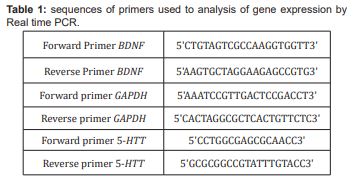

Gene expression findings
Expression analyses were showed significant down regulation of BDNF and 5-HTT genes in the addict group compared with the normal group. In addition, mRNA levels of BDNF and5-HTT were significantly increased in addicts after the six months of treatments with the DST method. Gene expression results including statistical data and ratio (2^∆∆Ct) were presented in table 3 and figure 1. Also, several significant correlations were found between the expression level of target genes and neuropsychological data. Statistical results of correlations for BDNF within each group were presented in table 4 and figure 2 and 5-HTT within each group table 5 and figure 3 respectively.

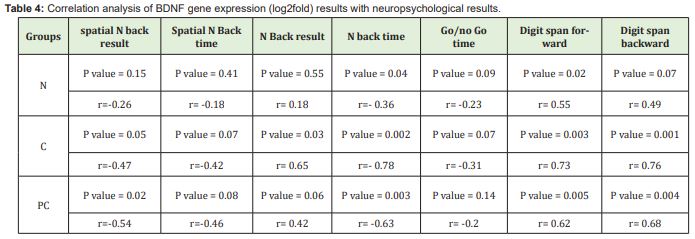
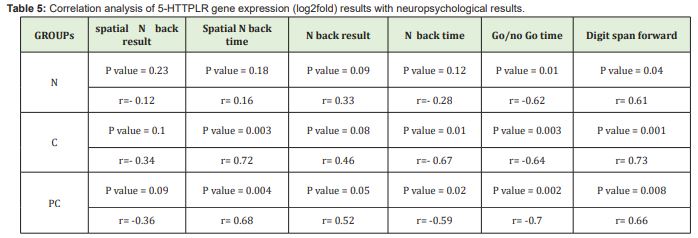
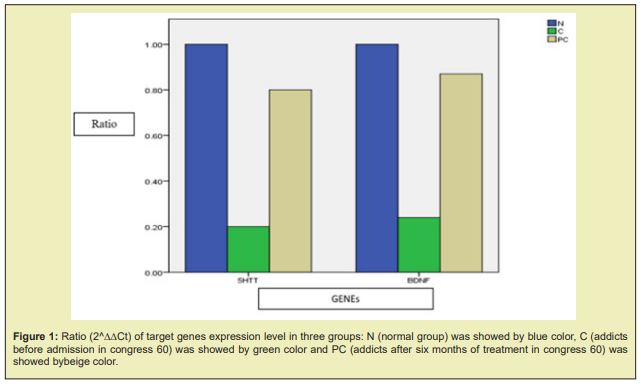
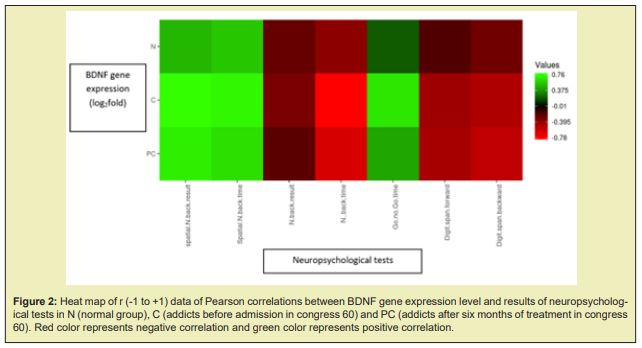
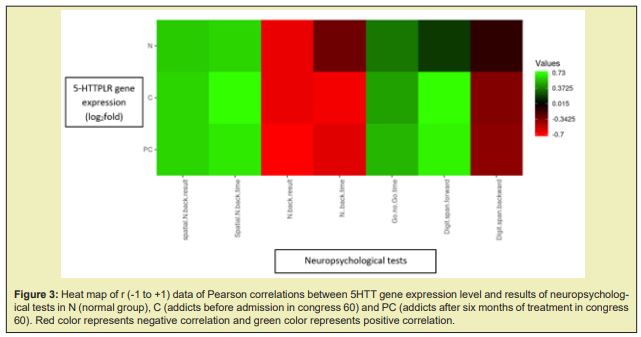
Western blotting results
In order to confirmation of gene expression results; protein levels of both BDNF and 5-HTT have been examined in three addict subjects and three non-psychiatric control groups. Findings were confirmed the gene expression data. BDNF and 5-HTT protein levels were lower in addicts compared with normal control. The protein level of both BDNF and 5-HTT were significantly increased in addicts after the six months of treatment. Results of protein level assessment were presented in table 6.
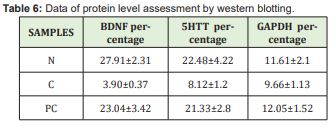
Cross-inheritance twin studies showed that substance-specific and substance-nonspecific genetic risk factors are both associated with addictions. Also, linkage studies have determined genes that are shared biomarkers in addiction and psychiatric disorders.5BDNF and 5-HTT are both candidate genes for several psychiatric disorders and several kinds of addictions.28-31
Results in the first period of sampling were showed a dramatic down-regulation of mRNA level in BDNF and 5-HTT in opioid addicts. Reduction in expression of these genes may cause a lack of cognitive and executive functions and lack of decision-making functions respectively. On the other hand, neuropsychological examinations have been detected memory and decision-making disabilities in addicts before starting the DST treatment method. After the six months of DST treatment which is half of all treatment periods, mRNA levels of BDNF and 5-HTT were significantly increased in addicts along with improvement of memory and decision-making abilities. Several correlations were found between BDNF and 5-HTT expression levels and memory testing results (digit span, spatial n-back, and n-back tests) and sustained attention and decision-making test (GO/no GO) respectively.
BDNF Recent evidence implicates epigenetic mechanisms in drug-associated memory processes. BDNF/TrkB activation could lead to overcoming memory and neuroplasticity reduction.32 Previous studies were revealed that BDNF plays an essential role in learning and memory including aversive memories associated with conditioned drug withdrawal. BDNF downregulation was found associated with memory deficiency and relapse of morphine.33 BDNF is also involved in neural circuits for visual long-term memory formation that may explain the correlations were found between mRNA level of BDNF and memory tests.34 Altogether it has been found that learning and memory and drug addiction are modulated by share neurotrophic factors, signaling pathways, and transcription factors. Addiction and memory are strongly related together with the same neuronal morphology adaptations and synaptic plasticity situations such as long-term potentiation (LTP) and long-term depression (LTD) in glutamatergic synapses.35 It may suggest that improvement of memory deficiencies which is common in addicts is a key to treatment of addiction and prevention of relapse. The study showed that both verbal and spatial memory of addicts were improved after six months and approached normal subjects. These improvements are highly correlated with the increase of BDNF expression.
Previous reports indicated that serotonin transporters are altered by chronic cocaine use, while also being involved in WM processing. A cohort study was showed that the variable number of tandem repeats and single-nucleotide polymorphisms in and high mRNA expression of 5-HTTLPR are associated with the worse executive working memory performance in cocaine users but with increased performance in controls.36 Other lines of evidence indicated that genetic variants and down expression of 5-HTT are detected in addiction as well as attention deficits and hyperactivity disorders.37,38 The present study has reported a significant down regulation of 5-HTT in addicts that was associated with lack of functions in memory, sustain attention, and decision making. While increased 5-HTT activity improves cognitive functioning, gene × environment interaction may cause complexity of the 5-HTT systems in different psychological situations and addictions.39 By the way, the DST method has reregulated the 5-HTT expression level as a biomarker for the number of psychiatric disorders compared with normal subjects.
It seems that DST as a package of psychological caring, group educations similar to cognitive behavioral therapy along with the taper method instead of using synthetic materials such as methadone could be a reliable alternative treatment for opioid addiction. Also, DST is not just a treatment method to reduce or cut the dependency of addicts on opioids but it can improve the cognitive problems, made by opioid abuse, as well. Improvement of cognitive abilities in addiction may consider as a harm reduction tool that also helps the addict to back to normal life.40
The present study was a follow-up of a new alternative method for the treatment of opioid addiction. We aimed to assess the rate of the change of neuropsychological and molecular situation of same subjects during the treatment to a better understanding of the nature of DST effectiveness. It seems that the DST method has successfully helped addicts to taper off and leave the opioid abuse without any second dependence on other substances or somatic or psychological side effects of a sudden leave of opioid abuse. In addition, psychological caring and educational programs for under treatment addicts or "passengers" have helped them to improve their cognitive abilities that are confirmed at both molecular and clinical levels. The study also confirmed the role of BDNF and serotonin transporters in memory functions and decision-making processes respectively.
None.
None.
Author declares that there is no conflict of interest.
- 1. Koob GF. Neurobiology of opioid addiction: opponent process, hyperkatifeia, and negative reinforcement. Biological psychiatry. 2020;87(1):44-53.
- 2. Savage SR, Joranson DE, Covington EC, et al. Definitions related to the medical use of opioids: evolution towards universal agreement. Journal of pain and symptom management. 2003;26(1):655-667.
- 3. Fathollahi MS, Torkashvand F, Najmeddin H, et al. Predictors of one-year retention in methadone maintenance treatment (MMT) in Iran, Rafsanjan. International journal of high-risk behaviors & addiction. 2016;5(3):e29121.
- 4. Kim TW, Alford DP, Malabanan A, et al. Low bone density in patients receiving methadone maintenance treatment. Drug and alcohol dependence. 2006;85(3):258-262.
- 5. Goldman D, Oroszi G, Ducci F. The genetics of addictions: uncovering the genes. Nature Reviews Genetics. 2005;6(7):521-532.
- 6. Le Foll B, Gallo A, et al. Genetics of dopamine receptors and drug addiction: a comprehensive review. Behavioural pharmacology. 2009;20(1):1-17.
- 7. Crews FT, Vetreno RP. Addiction, adolescence, and innate immune gene induction. Frontiers in psychiatry.2011;2:19.
- 8. Kreek MJ, Bart G, Lilly C, et al. Pharmacogenetics and human molecular genetics of opiate and cocaine addictions and their treatments. Pharmacological reviews. 2005;57(1):1-26.
- 9. Cryan JF, Dalvi A, Jin SH, et al. Use of dopamine-β-hydroxylase-deficient mice to determine the role of norepinephrine in the mechanism of action of antidepressant drugs. Journal of Pharmacology and Experimental Therapeutics. 2001;298(2):651-657.
- 10. Schroeder JP, Epps SA, Grice TW, et al. The selective dopamine β-hydroxylase inhibitor nepicastat attenuates multiple aspects of cocaine-seeking behavior. Neuropsychopharmacology. 2013;38(6):1032-1038.
- 11. Cadet JL. Epigenetics of stress, addiction, and resilience: therapeutic implications. Molecular neurobiology. 2016;53(1):545-560.
- 12. Boulle F, Van Den Hove D, Jakob S, et al. Epigenetic regulation of the BDNF gene: implications for psychiatric disorders. Molecular psychiatry. 2012;17(6):584-596.
- 13. Ikegame T, Bundo M, Sunaga F, et al. DNA methylation analysis of BDNF gene promoters in peripheral blood cells of schizophrenia patients. Neuroscience research. 2013;77(4):208-214.
- 14. Perkins KA, Lerman C, Grottenthaler A, et al. Dopamine and opioid gene variants are associated with increased smoking reward and reinforcement due to negative mood. Behavioural pharmacology. 2008;19(5-6):641.
- 15. Azadmarzabadi E, Haghighatfard A, Mohammadi A. Low resilience to stress is associated with candidate gene expression alterations in the dopaminergic signalling pathway. Psychogeriatrics. 2018;18(3):190-201.
- 16. Stoltenberg SF, Lehmann MK, Anderson C, et al. Serotonin transporter (5-HTTLPR) genotype and childhood trauma are associated with individual differences in decision making. Frontiers in genetics. 2011;2:33.
- 17. Juhasz G, Downey D, Hinvest N, et al. Risk-taking behavior in a gambling task associated with variations in the tryptophan hydroxylase 2 gene: relevance to psychiatric disorders. Neuropsychopharmacology. 2010;35(5):1109-19.
- 18. Blanco Gandía MC, Rodríguez Arias M. Pharmacological treatments for opiate and alcohol addiction: A historical perspective of the last 50 years. European journal of pharmacology.2018;836:89-101.
- 19. Ragia G, G Manolopoulos V. Personalized medicine of alcohol addiction: pharmacogenomics and beyond. Current pharmaceutical biotechnology. 2017;18(3):221-230.
- 20. Berrettini W. A brief review of the genetics and pharmacogenetics of opioid use disorders. Dialogues in clinical neuroscience. 2017;19(3):229.
- 21. Jaeggi SM, Buschkuehl M, Perrig WJ, et al. The concurrent validity of the N-back task as a working memory measure. Memory. 2010;18(4):394-412.
- 22. Jeter CB, Patel SS, Sereno AB. Novel n-back spatial working memory task using eye movement response. Behavior research methods. 2011;43(3):879-887.
- 23. Houck JM, Feldstein Ewing SW. Working memory capacity and addiction treatment outcomes in adolescents. The American journal of drug and alcohol abuse. 2018;44(2):185-192.
- 24. Shafiee-Kandjani AR, Mohammadzadeh Z, Amiri S, et al. Attention, working memory and executive functions in patients with internet addiction disorder. Journal of Injury and Violence Research. 2019;11(4 Suppl 2).
- 25. Balconi M, Finocchiaro R. Deficit in rewarding mechanisms and prefrontal left/right cortical effect in vulnerability for internet addiction. Acta Neuropsychiatrica. 2016;28(5):272-285.
- 26. Haghighatfard A, Andalib S, Amini Faskhodi M, et al. Gene expression study of mitochondrial complex I in schizophrenia and paranoid personality disorder. The World Journal of Biological Psychiatry. 2018;19(sup3):S133-S46.
- 27. Haghighatfard A. Expression Alteration of Disrupted in Schizophrenia 1 (DISC1) Gene, a Potential Peripheral Marker for Schizophrenia and Paranoid Personality Disorder. Hereditary Genet. 6: 188.
- 28. Haerian BS. BDNF rs6265 polymorphism and drug addiction: a systematic review and meta-analysis. Pharmacogenomics. 2013;14(16):2055-2065.
- 29. Xu X, Ji H, Liu G, et al. A significant association between BDNF promoter methylation and the risk of drug addiction. Gene. 2016;584(1):54-59.
- 30. Chen HX, Wang Y, Ye MJ, et al. Association of different susceptibilities to morphine with the expression of 5-HTT and 5-HT1AR mRNA in brain regions of SD rats. Zhong nan da xue xue bao Yi xue ban= Journal of Central South University Medical Sciences. 2008;33(9):775-783.
- 31. Samochowiec J, Kucharska Mazur J, Grzywacz A, et al. Family-based and case-control study of DRD2, DAT, 5HTT, COMT genes polymorphisms in alcohol dependence. Neuroscience letters. 2006;410(1):1-5.
- 32. White AO, Kramár EA, López AJ, et al. BDNF rescues BAF53b-dependent synaptic plasticity and cocaine-associated memory in the nucleus accumbens. Nature communications. 2016;7(1):1-12.
- 33. Ju YY, Long JD, Liu Y, et al. Formation of aversive memories associated with conditioned drug withdrawal requires BDNF expression in the amygdala in acute morphine-dependent rats. Acta Pharmacologica Sinica. 2015;36(12):1437-1443.
- 34. Tokuyama W, Okuno H, Hashimoto T, et al. BDNF upregulation during declarative memory formation in monkey inferior temporal cortex. Nature neuroscience. 2000;3(11):1134-1142.
- 35. Bolaños CA, Nestler EJ. Neurotrophic mechanisms in drug addiction. Neuromolecular medicine. 2004;5(1):69-83.
- 36. Havranek MM, Vonmoos M, Müller CP, et al. Serotonin transporter and tryptophan hydroxylase gene variations mediate working memory deficits of cocaine users. Neuropsychopharmacology. 2015;40(13):2929-2937.
- 37. Murthy N, Selvaraj S, Cowen PJ, et al. Serotonin transporter polymorphisms (SLC6A4 insertion/deletion and rs25531) do not affect the availability of 5-HTT to [11C] DASB binding in the living human brain. Neuroimage. 2010;52(1):50-54.
- 38. Manor I, Laiba E, Eisenberg J, et al. Association between trypotphan hydroxylase 2, performance on a continuance performance test and response to methylphenidate in ADHD participants. American Journal of Medical Genetics Part B: Neuropsychiatric Genetics. 2008;147(8):1501-1508.
- 39. Schipper P, Nonkes LJ, Karel P, et al. Serotonin transporter genotype x construction stress interaction in rats. Behavioural brain research. 2011;223(1):169-175.
- 40. Volkow ND, Wang GJ, Fowler JS, et al. Addiction circuitry in the human brain. Annual review of pharmacology and toxicology. 2012;52:321-336.

